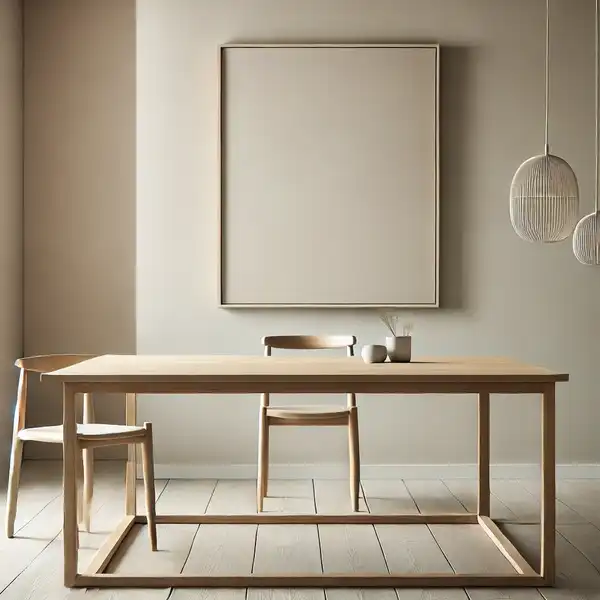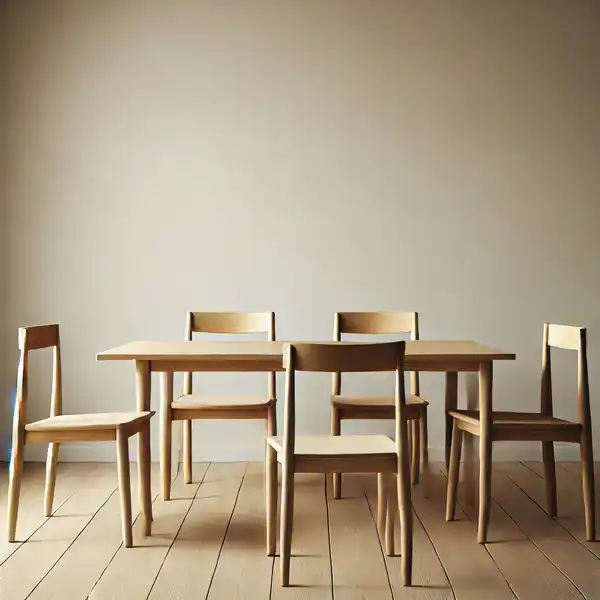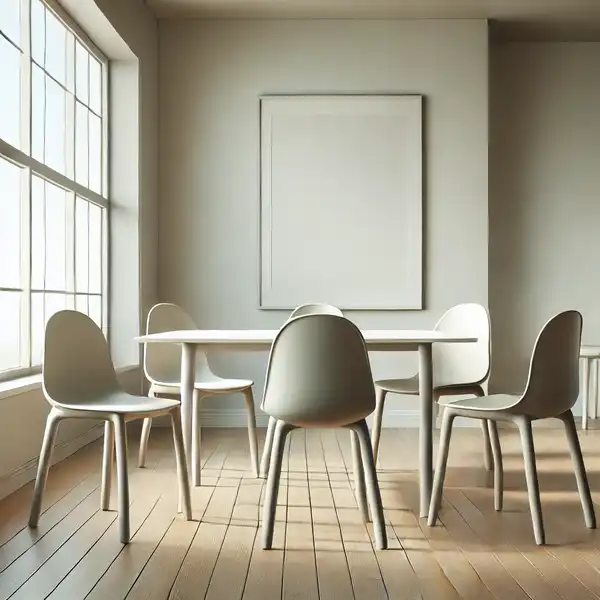Minimalist dining room ideas: Going minimalist with your dining room can feel nice. It makes the space clean, organized, and good to look at. Minimalism isn’t about taking everything out of the room. It’s more about finding beauty in simple things. Doing it right makes a minimalist dining room feel welcoming, inviting, and practical. Whether your dining space is small or big, the minimalist way makes creating a balanced and chill environment easy.
What Minimalism in Interior Design Means
Before getting into specific ideas, let’s clarify what minimalism in interior design means. It’s all about simplicity, function, and creating open spaces. Instead of filling rooms with furniture and decorations, minimalism focuses on what’s essential. The result is an airy, peaceful space without clutter.
Minimalist Dining Room Ideas
Let’s talk about how you can style your dining room minimally.
1. Pick a Simple Table

The table is a big deal in any dining room. For a minimalist look, go for something clean and functional. Look for tables without a bunch of decorative extras.
Some good options:
- Wood tables: Natural wood finishes can feel warm but not too bold.
- Glass tables keep things modern and open since you can see right through them!
- Metal tables: Adds an industrial vibe without taking over.
Keep the shape simple, too—rectangular or round works best here. And don’t overload the table with knickknacks. Less is more!
2. Stick to Neutral Colors

When designing a minimalist dining room, choose calm, neutral colors. This gives a peaceful, spacious feel.
Some color ideas:
- White: Clean and crisp. Perfect for a fresh look.
- Beige: Cozy and warm.
- Gray: Modern and sleek. It looks awesome with metal and glass.
Feel free to add some texture to furniture or decor. But keep the color palette pared down and consistent.
3. Choose Simple Seating

Minimalism applies to chairs, too. Pick seating that’s fuss-free but still comfy.
Some good picks:
- Wood chairs: Pair well with most tables and bring natural vibes.
- Metal chairs: Industrial cool.
- Plastic chairs: Budget-friendly and super modern.
You can add cushions for comfort, but keep patterns and colors minimalistic. A soft gray or beige is plenty.
4. Welcome Natural Light
Sunshine is key for a minimalist dining area. Big windows and breezy curtains make the space feel open and inviting. Mirrors can help reflect light if your room is dark.
Skip the heavy drapes. Sheer linen or fabric lets that beautiful light pour right in, keeping things bright and peaceful.
5. Declutter Like Crazy
Minimalism thrives when things feel organized and clutter-free. Clear out anything not needed for dining. Your room should just have the basics—that’s it.
Tips for decluttering:
- Lose extra furniture. Only keep essentials like the table and chairs.
- Limit decorations. Pick out a few meaningful pieces rather than filling up every surface.
- Use storage wisely. Stash extra stuff neatly in drawers and cabinets.
Keeping things pared down creates a relaxed, spacious mood.
6. Pick Basic Lighting
You need good lighting in a dining room, but with minimalism, you don’t want anything too crazy. Find lights that work but aren’t the main focus, like:
- Hanging pendant lights over the table
- Recessed lighting to keep things bright
- Wall sconces for a soft glow
Keep it simple in design and color. The lighting should help the room out, not take over.
7. Add Meaningful Decor
Minimalism doesn’t mean no decor at all! Just be thoughtful about what you choose, and don’t go overboard. A few good pieces can be:
- One large wall art piece
- Some plants or flowers
- Bowls or trays that look nice but are practical
Make sure whatever you pick fits the neutral color scheme and has a purpose.
8. Stick to Simple Floors
Your dining room floor should be basic to match the simple vibe. Hardwood is great if you have it! If not, some options are:
- Light wood
- Concrete
- Neutral tile
Adding a solid rug can make it cozier.
9. Keep Storage Low-Key
If you need storage, make sure it blends in. Skip the huge cabinets. Instead, try built-in storage or:
- Floating shelves
- A sideboard with clean lines
The goal is functional storage that fades into the background.
10. Add Personal Touches
Even in a minimalist room, you can add some personality with:
- Black and white family photos
- Meaningful keepsakes displayed simply
- One-of-a-kind furniture
Minimalism focuses on quality over quantity. Choose things that truly matter to you!
11. Add Greenery
- Succulents – These cute little plants are low maintenance and look awesome on a table or windowsill.
- Fiddle Leaf Figs – Bigger plants that add major height and interest to the room.
- Air Plants – These funky dudes need hardly any attention and can be shown off creatively.
When picking plant holders and pots, keep it simple. The focus should be on the actual plants themselves, not flashy containers.
12. Mixing Textures
Minimalism is all about simplicity, but blending different textures can also add interest. The key is keeping the colors neutral while switching up materials.
Try combining:
- Wood and metal for a cozy yet modern look
- Glass and stone for slick, eye-catching designs
- Linens and cottons for soft cushions or curtains
Mixing textures makes the space feel layered and dimensional without losing the minimalist vibe.
The Bottom Line
Minimalism isn’t about having less stuff – it’s about focusing on what matters. With these tips, you can design a dining room that’s peaceful, purposeful, and still super stylish.
Keep in mind:
- Stick with neutral colors
- Pick functional, straightforward furniture
- Welcome in natural light and limit knick-knacks
By following this simple advice, your dining room will feel open, cozy, and perfectly balanced. Minimalist design is a lifestyle centered around simplicity in every aspect of your home. And the dining room is a great place to start!